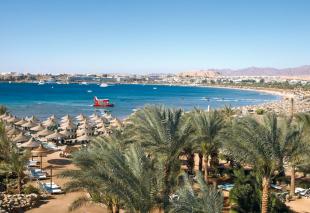

The charm behind Sharm el Sheikh

TRI Hospitality Consulting associate director Emma Davey goes digging behind the tourist attractions of Sharm el Sheikh to discover what makes the South Sinai resort destination tick
Sharm el Sheikh is the dominant tourist resort area in South Sinai, accounting for around 78% of the total hotel room supply in the Governate. Currently Sharm el Sheikh and Nabq Bay offer more than 48,000 hotel rooms, yet only 20 years ago it was a laid back and quiet hippy hangout for divers willing to make a long bus journey to experience the underwater delights of the Red Sea. Now, approximately 4.4 million visitors arrive each year at one of two terminals at Sharm el Sheikh airport, mainly on charter flights from Europe and Russia.
The central focus of Sharm el Sheikh is the Naama Bay area where the waterfront hotels are dissected by a public promenade bringing tourists along the pathway day and night.
However, the liveliest activity takes place behind the hotels to the north west corner of the bay where a pedestrian friendly area is littered with restaurants, bars, shisha cafes and the crowd-pulling Pascha nightclub.
In contrast, the Nabq Bay area, to the north of Sharm el Sheikh and under the control of the Tourism Development Authority, mainly provides destination resorts catering to the all-inclusive market with few leisure activities or entertainment attractions easily accessible outside the hotels.
Most of the sea frontage in Sharm el Sheikh is developed, with few remaining sites available. Many hotels have built extensions to their existing properties, usually behind a public road that divides the two sites.
However, this can lead to a potentially large number of guests vying for what is typically limited beach access, since extensive parts of the coastline is characterised by steep rocky sea frontage and coral ledges.
Sharm el Sheikh is considered to be a cheap holiday destination and this reputation was further fuelled by the all-inclusive package that emerged after the terrorist incidents in 2005 as a tool to attract the tourists back.
Whilst it has worked and occupancies in 2008 have returned to 2004 levels at around 80%, it has not helped leverage higher room rates.
With the exception of the Four Seasons hotel, the five-star properties offer standard tour package holiday fare, yet those in the Naama Bay area can attract higher rates due to their position near the only active centre in the resort town.
Given that Sharm el Sheikh has no commercial business, being only a resort town, one wonders what the next development step will encompass.
Although there is still significant land available stretching inland to the Sinai mountains, surely protection of the coastline will prevail and therefore limit any further development of room supply to this part of the coast.
It is likely that Sharm el Sheikh will need to move towards alternative recreational activities and if leisure developments are to be built in the remaining land, instead of further hotel rooms, then perhaps tourists can be persuaded to increase their spend during their stay.
If planned well, this would be a welcome boost to the local economy as tour operators often have a minimal positive impact on the livelihoods of the host country, particularly when the tourist is on an all inclusive package.
Unfortunately, the location is fundamentally locked into its dependence on tour operator business due to the lack of an open skies policy, with no scheduled flights to Sharm el Sheikh airport save for domestic flights operated by Egypt Air.
Independent travellers will pay higher room rates and typically book on a room only or bed and breakfast basis, extending the opportunity for additional spend both within the hotel and in the surrounding community.
The challenge for hoteliers is that the trip to Sharm el Sheikh is not that direct from most markets at present and despite Gulf based Arabs being regular leisure visitors to Cairo, this love affair has not been extended to any great degree to South Sinai. Sharm el Sheikh is just beyond comfortable reach for most independent travellers.
Of course, the danger of wanting to spruce up Sharm el Sheikh and give it the attributes of other “successful” resort destinations is that it may in fact lose the very charm that draws visitors there in the first place. Sharm el Sheikh attracts repeat visitors, with some hotels even showering recognition on those that have returned loyally year after year to the same property. Whether it is affordability, the guaranteed sunshine or the tour package experience that brings the guests back, it is hard to say, but without them Sharm el Sheikh would not have grown to be the resort destination it is today.